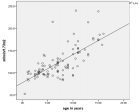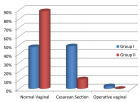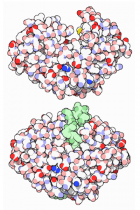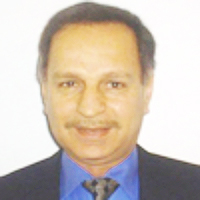Abstract
Research Article
Perceptions of Adolescent Mothers on Feeding and Nutrition of their Children aged 0-3 Years in Rural Bangladesh
Faiza Farzana* and Tanvir Sarwar
Published: 16 June, 2023 | Volume 7 - Issue 1 | Pages: 054-064
Proper feeding practices at an early age are the key to improving a child’s overall health and achieving developmental milestones. In Bangladesh, a large portion of rural girls become mothers before the age of 18. Past records show that most interventions are designed to improve infant and young child feeding practices targeting older mothers. That is why, this study has been designed with an aim to explore the perceptions and practices of infant and young children feeding among rural Bangladeshi mothers aged <19 years old. Data was collected through in-depth interviews and group discussions with a total of 40 adolescent mothers who have children aged 0-3 years. Data has revealed that the majority of the mothers hold very limited knowledge of nutrition and child nutrition but those who are educationally a bit ahead hold a little better knowledge. Participants are aware of breastfeeding but they all misinterpret the term ‘exclusive breastfeeding’ with other liquid food. It has also emerged that most of the mothers know the ideal timing of starting complementary feeding but very few of them actually understand what to feed children. In spite of having misconceptions and superstation rural adolescent mothers practice responsive feeding instead of force-feeding. No gender discrimination has been found regarding child feeding. The findings of the study pinpointed that mothers are unable to practice proper infant and child feeding due to a lack of knowledge and limited affordability. Educating girls & young mothers and improving financial security could be an effective way to promote improved infant feeding practices.
Read Full Article HTML DOI: 10.29328/journal.afns.1001050 Cite this Article Read Full Article PDF
Keywords:
In Rural Bangladesh; Adolescent mothers; Infant; Young children; Exclusive breastfeeding; Complementary feeding
References
- Chen LC, Chowdhury A, Huffman SL. Anthropometric assessment of energy-protein malnutrition and subsequent risk of mortality among preschool aged children. Am J Clin Nutr. 1980 Aug;33(8):1836-45. doi: 10.1093/ajcn/33.8.1836. PMID: 6773410.
- Bardosono S, Sastroamidjojo S, Lukito W. Determinants of child malnutrition during the 1999 economic crisis in selected poor areas of Indonesia. Asia Pac J Clin Nutr. 2007;16(3):512-26. PMID: 17704034.
- Khanal V, Sauer K, Zhao Y. Determinants of complementary feeding practices among Nepalese children aged 6-23 months: findings from Demographic and Health Survey 2011. BMC Pediatr. 2013 Aug 28;13:131. doi: 10.1186/1471-2431-13-131. PMID: 23981670; PMCID: PMC3766108.
- Dibley MJ, Roy SK, Senarath U, Patel A, Tiwari K, Agho KE, Mihrshahi S; South Asia Infant Feeding Research Network. Across-country comparisons of selected infant and young child feeding indicators and associated factors in four South Asian countries. Food Nutr Bull. 2010 Jun;31(2):366-75. doi: 10.1177/156482651003100224. PMID: 20707239.
- Kabir I, Khanam M, Agho KE, Mihrshahi S, Dibley MJ, Roy SK. Determinants of inappropriate complementary feeding practices in infant and young children in Bangladesh: secondary data analysis of Demographic Health Survey 2007. Matern Child Nutr. 2012 Jan;8 Suppl 1(Suppl 1):11-27. doi: 10.1111/j.1740-8709.2011.00379.x. PMID: 22168516; PMCID: PMC6860519.
- World Health Organization (WHO) (2009) Infant and Young Child Feeding: Model Chapter for Textbooks for Medical Students and Allied Health Professionals. WHO: Geneva.
- World Health Organization (WHO). (2009). Global Data Bank on Infant and Young Child Feeding. http://apps.who.int/iris/bitstream/handle/10665/44117/9789241597494_eng.pdf?sequence=1
- Saizuddin M, Hasan MS. Infant and Young Child Feeding (IYCF) Practices by Rural Mothers of Bangladesh. Journal of National Institute of Neurosciences Bangladesh. 2017; 2(1): 19-25.
- Huq KO, Haque N, Akther F. Comparison of the Nutritional Status and Infant Feeding Practices Between Selected Rural and Urban Areas in Bangladesh. Journal of Food and Nutrition Sciences. 2017; 5(5): 167.
- Gyampoh S, Otoo GE, Aryeetey RN. Child feeding knowledge and practices among women participating in growth monitoring and promotion in Accra, Ghana. BMC Pregnancy Childbirth. 2014 May 29;14:180. doi: 10.1186/1471-2393-14-180. PMID: 24886576; PMCID: PMC4047542.
- Egata G, Berhane Y, Worku A. Predictors of non-exclusive breastfeeding at 6 months among rural mothers in east Ethiopia: a community-based analytical cross-sectional study. Int Breastfeed J. 2013 Aug 7;8(1):8. doi: 10.1186/1746-4358-8-8. PMID: 23919800; PMCID: PMC3750393.
- Central Statistical Agency [Ethiopia]. ICF International. Ethiopia demographic and health survey. Addis Ababa and Calverton: Central Statistical Agency and ICF International. 2012. https://dhsprogram.com/publications/publication-fr255-dhs-final-reports.cfm
- United Nations Children's Fund (UNICEF), Bangladesh. Infant and young child feeding. 2020. Retrieved from, https://www.unicef.org/bangladesh/sites/unicef.org.bangladesh/files/2018-10/Guidelines%20for%20CF.pdf
- Eneroth H, El Arifeen S, Persson LA, Kabir I, Lönnerdal B, Hossain MB, Ekström EC. Duration of exclusive breast-feeding and infant iron and zinc status in rural Bangladesh. J Nutr. 2009 Aug;139(8):1562-7. doi: 10.3945/jn.109.104919. Epub 2009 Jun 17. PMID: 19535419.
- Giashuddin MS, Kabir M. Duration of breast-feeding in Bangladesh. Indian J Med Res. 2004 Jun;119(6):267-72. PMID: 15243164.
- Huffman SL, Chowdhury A, Chakraborty J, Simpson NK. Breast-feeding patterns in rural Bangladesh. Am J Clin Nutr. 1980 Jan;33(1):144-54. doi: 10.1093/ajcn/33.1.144. PMID: 7355776.
- Rasheed S, Haider R, Hassan N, Pachón H, Islam S, Jalal CS, Sanghvi TG. Why does nutrition deteriorate rapidly among children under 2 years of age? Using qualitative methods to understand community perspectives on complementary feeding practices in Bangladesh. Food Nutr Bull. 2011 Sep;32(3):192-200. doi: 10.1177/156482651103200302. PMID: 22073792.
- Haider R, Kabir I, Hamadani JD, Habte D. Reasons for failure of breast-feeding counselling: mothers' perspectives in Bangladesh. Bull World Health Organ. 1997;75(3):191-6. PMID: 9277005; PMCID: PMC2486944.
- World Health Organization (WHO). Pregnant Adolescents: Delivering on Global Promises of Hope. 2006. https://apps.who.int/iris/handle/10665/43368
- Haggarty L. What is content analysis? Medical Teacher. 1996; 18(2): 99–101.
- Braun V, Clarke V. Using thematic analysis in psychology. Qualitative Research
in Psychology. 2006; 3(2): 77–101. - Caldwell JC. Education as a Factor in Mortality Decline: An Examination of Nigerian Data. Population Studies. 1979; 33(3): 395-413.
- Kabubo-Mariara J, Ndenge DK. Determinants of Children's Nutritional Status in Kenya: Evidence from Demographic and Health Surveys. Journal of African Economies. 2009; 18(3): 363–87.
- Ruel MT, Habicht JP, Pinstrup-Andersen P, Gröhn Y. The mediating effect of maternal nutrition knowledge on the association between maternal schooling and child nutritional status in Lesotho. Am J Epidemiol. 1992 Apr 15;135(8):904-14. doi: 10.1093/oxfordjournals.aje.a116386. PMID: 1585903.
- Mosley WH, Chen LC. An Analytical Framework for the Study of Child Survival in Developing Countries. Population and Development Review. 1984; 10(Supplement): 25–45.
- Hackett KM, Mukta US, Jalal CS, Sellen DW. Knowledge, attitudes and perceptions on infant and young child nutrition and feeding among adolescent girls and young mothers in rural Bangladesh. Matern Child Nutr. 2015 Apr;11(2):173-89. doi: 10.1111/mcn.12007. Epub 2012 Oct 15. PMID: 23061427; PMCID: PMC6860341.
- Dykes F, Williams C. Falling by the wayside: a phenomenological exploration of perceived breast-milk inadequacy in lactating women. Midwifery. 1999 Dec;15(4):232-46. doi: 10.1054/midw.1999.0185. PMID: 11216257.
- Islam MZ, Farjana S, Masud JHB. Complementary feeding practices among the
mothers of a rural community. Northern International Medical College Journal. 2012; 3(2):
204-207. - Akhtar K, Hoque ME, Islam MZ, Yusuf MA, Sharif AR, Ahsan AI. Feeding
Pattern and Nutritional Status of Under Two Years Slum Children. J Shaheed Suhrawardy Medical College. 2012; 4(1): 3-6. - Karim M, Farah S, Jannat FJ. Study on feeding practices of infants among the
mothers in selected villages, at Dhamrai. J. Dhaka National Medical College Hospital. 2012;
18(02): 30-36. - Engle PL, Bentley M, Pelto G. The role of care in nutrition programmes: current research and a research agenda. Proc Nutr Soc. 2000 Feb;59(1):25-35. doi: 10.1017/s0029665100000045. PMID: 10828171.
- Pelto GH, Levitt E, Thairu L. Improving feeding practices: current patterns, common constraints, and the design of interventions. Food Nutr Bull. 2003 Mar;24(1):45-82. doi: 10.1177/156482650302400104. PMID: 12664527.
- Pryer JA, Rogers S, Rahman A. The epidemiology of good nutritional status among children from a population with a high prevalence of malnutrition. Public Health Nutr. 2004 Apr;7(2):311-7. doi: 10.1079/PHN2003530. PMID: 15003139.
- Rahman MA, Khan MN, Akter S, Rahman A, Alam MM, Khan MA, Rahman MM. Determinants of exclusive breastfeeding practice in Bangladesh: Evidence from nationally representative survey data. PLoS One. 2020 Jul 15;15(7):e0236080. doi: 10.1371/journal.pone.0236080. PMID: 32667942; PMCID: PMC7363092.
Figures:
Similar Articles
-
Assessment of Complementary Feeding Practice of infants and young children aged 6-23 months in Gode Town, Somali Regional State of EthiopiaYimer Mihretie*. Assessment of Complementary Feeding Practice of infants and young children aged 6-23 months in Gode Town, Somali Regional State of Ethiopia. . 2017 doi: 10.29328/journal.afns.1001008; 1: 045-057
-
Iodine status and thyroid parameters of pregnant women living in an iodine sufficient areaFereidoun Azizi*,Hossein Delshad,Parvin Mirmiran,Ladan Mehran,Maryam Tohidi. Iodine status and thyroid parameters of pregnant women living in an iodine sufficient area. . 2021 doi: 10.29328/journal.afns.1001026; 5: 001-006
-
Mild to moderate iodine deficiency in pregnancy: A matter of debateFereidoun Azizi*,Hossein Delshad. Mild to moderate iodine deficiency in pregnancy: A matter of debate. . 2021 doi: 10.29328/journal.afns.1001028; 5: 018-026
-
Perceptions of Adolescent Mothers on Feeding and Nutrition of their Children aged 0-3 Years in Rural BangladeshFaiza Farzana*, Tanvir Sarwar. Perceptions of Adolescent Mothers on Feeding and Nutrition of their Children aged 0-3 Years in Rural Bangladesh. . 2023 doi: 10.29328/journal.afns.1001050; 7: 054-064
-
Impact of Moringa oleifera Leaf Flour supplement on Weight Gain in Moderately Acutely Malnourished Children in BeninLaleye Flora Tinouade Founmilayo*, Fanou Fogny Nadia and Kayode Polycarpe. Impact of Moringa oleifera Leaf Flour supplement on Weight Gain in Moderately Acutely Malnourished Children in Benin. . 2023 doi: 10.29328/journal.afns.1001052; 7: 070-077
-
Evaluation of Heavy Metals in Commercial Baby FoodsOmobolanle David Garuba, Judith C Anglin, Sonya Good, Shodimu-Emmanuel Olufemi, Olubukola Monisola Oyawoye, Sodipe Ayodotun*. Evaluation of Heavy Metals in Commercial Baby Foods. . 2024 doi: 10.29328/journal.afns.1001056; 8: 012-020
Recently Viewed
-
A Low-cost High-throughput Targeted Sequencing for the Accurate Detection of Respiratory Tract PathogenChangyan Ju, Chengbosen Zhou, Zhezhi Deng, Jingwei Gao, Weizhao Jiang, Hanbing Zeng, Haiwei Huang, Yongxiang Duan, David X Deng*. A Low-cost High-throughput Targeted Sequencing for the Accurate Detection of Respiratory Tract Pathogen. Int J Clin Virol. 2024: doi: 10.29328/journal.ijcv.1001056; 8: 001-007
-
A Comparative Study of Metoprolol and Amlodipine on Mortality, Disability and Complication in Acute StrokeJayantee Kalita*,Dhiraj Kumar,Nagendra B Gutti,Sandeep K Gupta,Anadi Mishra,Vivek Singh. A Comparative Study of Metoprolol and Amlodipine on Mortality, Disability and Complication in Acute Stroke. J Neurosci Neurol Disord. 2025: doi: 10.29328/journal.jnnd.1001108; 9: 039-045
-
Development of qualitative GC MS method for simultaneous identification of PM-CCM a modified illicit drugs preparation and its modern-day application in drug-facilitated crimesBhagat Singh*,Satish R Nailkar,Chetansen A Bhadkambekar,Suneel Prajapati,Sukhminder Kaur. Development of qualitative GC MS method for simultaneous identification of PM-CCM a modified illicit drugs preparation and its modern-day application in drug-facilitated crimes. J Forensic Sci Res. 2023: doi: 10.29328/journal.jfsr.1001043; 7: 004-010
-
A Gateway to Metal Resistance: Bacterial Response to Heavy Metal Toxicity in the Biological EnvironmentLoai Aljerf*,Nuha AlMasri. A Gateway to Metal Resistance: Bacterial Response to Heavy Metal Toxicity in the Biological Environment. Ann Adv Chem. 2018: doi: 10.29328/journal.aac.1001012; 2: 032-044
-
Obesity in Patients with Chronic Obstructive Pulmonary Disease as a Separate Clinical PhenotypeDaria A Prokonich*, Tatiana V Saprina, Ekaterina B Bukreeva. Obesity in Patients with Chronic Obstructive Pulmonary Disease as a Separate Clinical Phenotype. J Pulmonol Respir Res. 2024: doi: 10.29328/journal.jprr.1001060; 8: 053-055
Most Viewed
-
Evaluation of Biostimulants Based on Recovered Protein Hydrolysates from Animal By-products as Plant Growth EnhancersH Pérez-Aguilar*, M Lacruz-Asaro, F Arán-Ais. Evaluation of Biostimulants Based on Recovered Protein Hydrolysates from Animal By-products as Plant Growth Enhancers. J Plant Sci Phytopathol. 2023 doi: 10.29328/journal.jpsp.1001104; 7: 042-047
-
Sinonasal Myxoma Extending into the Orbit in a 4-Year Old: A Case PresentationJulian A Purrinos*, Ramzi Younis. Sinonasal Myxoma Extending into the Orbit in a 4-Year Old: A Case Presentation. Arch Case Rep. 2024 doi: 10.29328/journal.acr.1001099; 8: 075-077
-
Feasibility study of magnetic sensing for detecting single-neuron action potentialsDenis Tonini,Kai Wu,Renata Saha,Jian-Ping Wang*. Feasibility study of magnetic sensing for detecting single-neuron action potentials. Ann Biomed Sci Eng. 2022 doi: 10.29328/journal.abse.1001018; 6: 019-029
-
Pediatric Dysgerminoma: Unveiling a Rare Ovarian TumorFaten Limaiem*, Khalil Saffar, Ahmed Halouani. Pediatric Dysgerminoma: Unveiling a Rare Ovarian Tumor. Arch Case Rep. 2024 doi: 10.29328/journal.acr.1001087; 8: 010-013
-
Physical activity can change the physiological and psychological circumstances during COVID-19 pandemic: A narrative reviewKhashayar Maroufi*. Physical activity can change the physiological and psychological circumstances during COVID-19 pandemic: A narrative review. J Sports Med Ther. 2021 doi: 10.29328/journal.jsmt.1001051; 6: 001-007

HSPI: We're glad you're here. Please click "create a new Query" if you are a new visitor to our website and need further information from us.
If you are already a member of our network and need to keep track of any developments regarding a question you have already submitted, click "take me to my Query."














































































































































